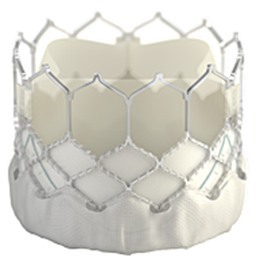Edwards SAPIEN 3 Transcatheter Heart Valve System with Edwards Commander Delivery System – P200015
This is a brief overview of information related to FDA’s approval to market this product. See the links below to the Summary of Safety and Effectiveness Data (SSED) and product labeling for more complete information on this product, its indications for use, and the basis for FDA’s approval.
Product Name: Edwards SAPIEN 3 Transcatheter Heart Valve System with Edwards Commander Delivery System
PMA Applicant: Edwards Lifesciences LLC
Address: One Edwards Way, Irvine, CA 92614
Approval Date: August 31, 2020
Approval Letter: Approval Order
What is it? The Edwards SAPIEN 3 Transcatheter Heart Valve (THV) System with Edwards Commander Delivery System consists of a catheter-based artificial heart valve and accessories used to implant the valve without open-heart surgery. The valve is made of cow tissue attached to a balloon-expandable, cobalt-chromium frame for support.
The Edwards SAPIEN 3 THV System with Edwards Commander Delivery System was previously approved for the treatment of severe aortic stenosis (a narrowing of the aortic valve that restricts blood flow to aorta, the body's main artery). This approval expands the indications for use to include treatment of severe pulmonary regurgitation, when blood leaks back into the heart from a leaky pulmonary valve, or pulmonary stenosis, when the pulmonary valve narrows and restricts blood flow.
How does it work? The doctor compresses the SAPIEN 3 THV and places it on the end of a tube-like device called a balloon catheter. The doctor then moves the catheter with the mounted SAPIEN 3 THV through a large vein in the leg. The catheter is pushed through the blood vessels until it reaches the pulmonary valve. The artificial valve is then expanded by a balloon and it anchors to the valve that needs replacement. Once the new valve is in place, it functions the same as the old valve, opening and closing like a door to force the blood to flow in the correct direction.
When is it used? The Edwards SAPIEN 3 THV is used to replace a failing pulmonary valve in patients born with heart defects. Often, these patients first receive a pulmonary valve conduit, which is an artificial graft, or tube, with a valve inside that connects the heart to the lungs, or they receive an artificial heart valve. Both aim to restore blood flow through the pulmonary valve. Over time, the conduit or artificial heart valve may become narrow or develop a leak, and the SAPIEN 3 THV can be used as the replacement valve without open heart surgery.
What will it accomplish? The SAPIEN 3 THV may be used in place of open heart surgery for a valve replacement, giving the patient more time between open heart surgeries or reducing the total number of open heart surgeries the patient needs.
In a clinical study of the SAPIEN 3 THV, the device became narrowed, developed a leak, or required replacement, in about five out of 100 patients at one year. Complications reported in the clinical study included tearing of the valve conduit in about nine out of 100 patients during the procedure. Irregular heart beat occurred in about four out of 100 patients at 30 days after the procedure and eight out of 100 patients at one year after the procedure. Minor bleeding occurred in about 11 out of 100 patients at 30 days after the procedure and minor injuries to the blood vessel in about 13 out of 100 patients at 30 days after the procedure.
When should it not be used? The SAPIEN 3 THV should not be used in:
- Patients who cannot tolerate blood thinning medicines.
- Patients who have an infection in the heart or elsewhere.
Additional information (including warnings, precautions, and adverse events):

